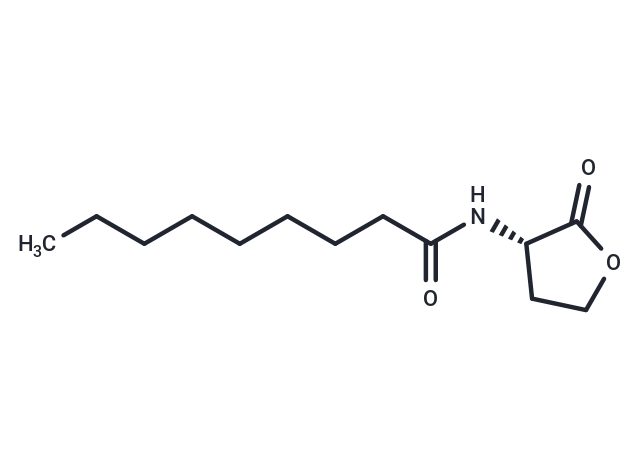 您的购物车当前为空
您的购物车当前为空
N-Nonanoyl-L-homoserine lactone
一键复制产品信息产品编号 TYD-01007Cas号 177158-21-3
N-酰化高丝氨酸内酯 (AHL) 是一种用于细菌群体感应的自诱导剂。在这种系统中,细菌通过产生、释放和检测小的可扩散信号分子来调整基因表达,以应对细胞密度的变化。该过程与生物膜的形成和毒力因子的产生有关。AHL 通常由与高丝氨酸内酯 (HSL) 偶联的脂肪酸构成,酰基长度(C4-C18)、C3 取代(氢、羟基或氧代基团)以及脂肪酸链中的碳-碳双键数目皆会影响信号的特异性。这种特异性由 LuxR 家族的转录调节因子的亲和力决定。抑制细菌群体感应信号系统以对抗病原机制,是传染病抗微生物治疗研究的新方向。C9-HSL 是一种罕见的奇数酰基碳链,由在营养丰富的 Luria-Bertani 肉汤 (LB) 培养基中生长的野生型胡萝卜软腐欧文氏菌菌株 SCC 3193 产生。

N-Nonanoyl-L-homoserine lactone
一键复制产品信息产品编号 TYD-01007Cas号 177158-21-3
N-酰化高丝氨酸内酯 (AHL) 是一种用于细菌群体感应的自诱导剂。在这种系统中,细菌通过产生、释放和检测小的可扩散信号分子来调整基因表达,以应对细胞密度的变化。该过程与生物膜的形成和毒力因子的产生有关。AHL 通常由与高丝氨酸内酯 (HSL) 偶联的脂肪酸构成,酰基长度(C4-C18)、C3 取代(氢、羟基或氧代基团)以及脂肪酸链中的碳-碳双键数目皆会影响信号的特异性。这种特异性由 LuxR 家族的转录调节因子的亲和力决定。抑制细菌群体感应信号系统以对抗病原机制,是传染病抗微生物治疗研究的新方向。C9-HSL 是一种罕见的奇数酰基碳链,由在营养丰富的 Luria-Bertani 肉汤 (LB) 培养基中生长的野生型胡萝卜软腐欧文氏菌菌株 SCC 3193 产生。
| 规格 | 价格 | 库存 | 数量 |
|---|---|---|---|
| 5 mg | 待询 | 待询 | |
| 10 mg | 待询 | 待询 | |
| 50 mg | 待询 | 待询 |
大包装 & 定制
TargetMol 的所有产品仅用作科学研究或药证申报,不能被用于人体,我们不向个人提供产品和服务。请您遵守承诺用途,不得违反法律法规规定用于任何其他用途。
联系我们获取更多批次信息
资源下载
产品介绍
生物活性
化学信息
| 产品描述 | N-Acyl homoserine lactones (AHLs) are a class of autoinducers used by bacteria in quorum sensing, a regulatory system controlling gene expression in response to increased cell density. This regulation leads to diverse phenotypes, such as biofilm formation and production of virulence factors. Coordinated gene expression is achieved through the generation, release, and detection of small diffusible signal molecules called autoinducers. AHLs typically consist of fatty acids linked to homoserine lactone (HSL). Modulating bacterial quorum sensing signal systems to suppress pathogenesis offers a novel antimicrobial approach in studying infectious diseases. AHLs vary in acyl chain length (C4-C18), C3 substitution (hydrogen, hydroxyl, or oxo groups), and the presence or absence of carbon-carbon double bonds, providing signal specificity via LuxR family transcription factors. C9-HSL, characterized by an unusual odd-numbered acyl carbon chain, is produced by the wild-type Erwinia carotovora subsp. carotovora strain SCC 3193 grown in nutrient-rich Luria-Bertani broth (LB). |
| 分子量 | 241.33 |
| 分子式 | C13H23NO3 |
| CAS No. | 177158-21-3 |
储存&溶解度
| 存储 | Powder: -20°C for 3 years | In solvent: -80°C for 1 year |
计算器
体内实验配液计算器
请在以下方框中输入您的动物实验信息后点击计算,可以得到母液配置方法和体内配方的制备方法:
剂量转换
对于不同动物的给药剂量换算,您也可以参考 更多
引用文献
评论列表
Related Tags: buy N-Nonanoyl-L-homoserine lactone | purchase N-Nonanoyl-L-homoserine lactone | N-Nonanoyl-L-homoserine lactone cost | order N-Nonanoyl-L-homoserine lactone | N-Nonanoyl-L-homoserine lactone chemical structure | N-Nonanoyl-L-homoserine lactone formula | N-Nonanoyl-L-homoserine lactone molecular weight





 还可以
还可以

 |
|
评论内容